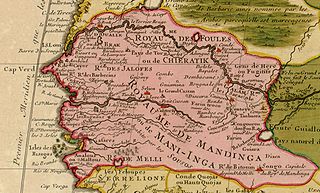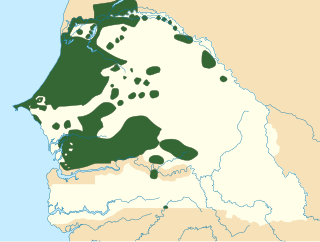Related Research Articles

The history of Senegal is commonly divided into a number of periods, encompassing the prehistoric era, the precolonial period, colonialism, and the contemporary era.

Dakar, is the capital and largest city of Senegal. The city of Dakar proper has a population of 1,030,594, whereas the population of the Dakar metropolitan area is estimated at 3.94 million in 2021.

Wolof is a language of Senegal, Mauritania, and the Gambia, and the native language of the Wolof people. Like the neighbouring languages Serer and Fula, it belongs to the Senegambian branch of the Niger–Congo language family. Unlike most other languages of the Niger-Congo family, Wolof is not a tonal language.

A leprechaun is a diminutive supernatural being in Irish folklore, classed by some as a type of solitary fairy. They are usually depicted as little bearded men, wearing a coat and hat, who partake in mischief. In later times, they have been depicted as shoe-makers who have a hidden pot of gold at the end of the rainbow.

A kobold is a mythical sprite. Having spread into Europe with various spellings including "goblin" and "hobgoblin", and later taking root and stemming from Germanic mythology, the concept survived into modern times in German folklore.

The púca, pucapwca, pooka, phouka, puck is a creature of Celtic, English, and Channel Islands folklore. Considered to be bringers both of good and bad fortune, they could help or hinder rural and marine communities. Púcaí can have dark or white fur or hair. The creatures were said to be shape-changers that could take the appearance of horses, goats, cats, dogs, and hares. They may also take a human form, which includes various animal features, such as ears or a tail.
The Senegambia is, in the narrow sense, a historical name for a geographical region in West Africa, which lies between the Senegal River in the north and the Gambia River in the south. However, there are also text sources which state that Senegambia is understood in a broader sense and equated with the term the Western region. This refers to the coastal areas between Senegal and Sierra Leone, where the inland border in the east was not further defined.

Saint Louis or Saint-Louis, is the capital of Senegal's Saint-Louis Region. Located in the northwest of Senegal, near the mouth of the Senegal River, and 320 kilometres (200 mi) north of Senegal's capital city Dakar, it has a population officially estimated at 258,592 in 2021. Saint-Louis was the capital of the French colony of Senegal from 1673 until 1902 and French West Africa from 1895 until 1902, when the capital was moved to Dakar. From 1920 to 1957, it also served as the capital of the neighboring colony of Mauritania.

In Breton folklore, a Korrigan is a fairy or dwarf-like spirit. The word korrigan means in Breton "small-dwarf". It is closely related to the Cornish word korrik which means gnome. The name changes according to the place. Among the other names, there are korrig, korred, korrs, kores, couril, crion, goric, kornandon, ozigan, nozigan, teuz, torrigan, viltañs, poulpikan, poulpiquet, and paotred ar sabad.
Thomas Keightley was an Irish writer known for his works on mythology and folklore, particularly Fairy Mythology (1828), later reprinted as The World Guide to Gnomes, Fairies, Elves, and Other Little People.

Rufisque is a city in the Dakar region of western Senegal, at the base of the Cap-Vert Peninsula. It has a population of 179,797. In the past it was an important port city in its own right, but is now a suburb of Dakar.
In French mythology or folklore, Dames Blanches were female spirits or supernatural beings, comparable to the Weiße Frauen of both Dutch and German mythology. The Dames Blanches were reported in the region of Lorraine (Lotharingen) and Normandy. They appear, in the Pyrenees mountains, where they were supposed to appear near caves and caverns.
Mythic humanoids are mythological creatures that are part human, or that resemble humans through appearance or character. Each culture has different mythical creatures that come from many different origins. A major chunk of these creatures are humanoids. They are often able to talk and in many stories they guide the hero on their journey. They are said to come before the creation of gods and goddesses.

There are various ethnic groups in Senegal, The Wolof according to CIA statistics are the majority ethnic group in Senegal. Many subgroups of those can be further distinguished, based on religion, location and language. According to one 2005 estimate, there are at least twenty distinguishable groups of largely varying size.

Tiep or thieb is a traditional dish from Senegambia that is also consumed in Guinea Bissau, Guinea, Mali and Mauritania. It is the national dish in Senegal. The version of tiep called thieboudienne or chebu jen is prepared with fish, rice and tomato sauce cooked in one pot. There are also tiep yappa and tiep ganaar. Additional ingredients often include onions, carrots, cabbage, cassava, hot pepper, lime and peanut oil, and stock cubes.
The French conquest of Senegal started in 1659 with the establishment of Saint-Louis, Senegal, followed by the French capture of the island of Gorée from the Dutch in 1677, but would only become a full-scale campaign in the 19th century.
Senegalese Americans are an ethnic group of Americans of Senegalese descent. In the surveys of 2019, 18,091 people claimed to be of Senegalese origin or descent in the United States. However, many West Africans trafficked by enslavers to the United States were also of Senegalese origin. Thus many African Americans may also have some ancestors of this country.

West African mythology is the body of myths of the people of West Africa. It consists of tales of various deities, beings, legendary creatures, heroes and folktales from various ethnic groups. Some of these myths traveled across the Atlantic during the period of the Trans-Atlantic slave trade to become part of Caribbean, Cuban and Brazilian mythology.

The Battle of Logandème was an uprising led by the Serer King Maad a Sinig Kumba Ndoffene Famak Joof, king of Sine, against the French Empire. The battle took place at Logandème which was a part of Sine at the time. The battle was also a revenge attack against the Serer people after their resounding victory against France at the Battle of Djilass on 13 May 1859. It was the first time that France decided to employ cannonball in the Senegambia.
References
- ↑ "Yumboe" is a Lebou word. Although the Lebou people speak the Wolof language, the Wolof language itself comes from the Lebou people, it was their original language. Goree is also Lebou country not Wolof. Various tribes also inhabit(ed) Jolof (Jallof).
- 1 2 Keightley, Thomas. "The Fairy Mythology: Illustrative of the Romance and Superstition of Various Countries", George Bell and Sons (1892), pp. 495-496.
- ↑ Allardice, Pamela. Myths, Gods & Fantasy. ABC-CLIO (1991), p. 227. ISBN 978-0874366600
- ↑ Gray, Louis H. (Louis Herbert); Moore, George Foot; MacCulloch, J. A. (John Arnott) (1916). The Mythology of all races ... Duke University Libraries. Boston, Marshall Jones Company.
- ↑ "History of the Quidditch World Cup - Pottermore". Pottermore. Retrieved 2018-08-28.